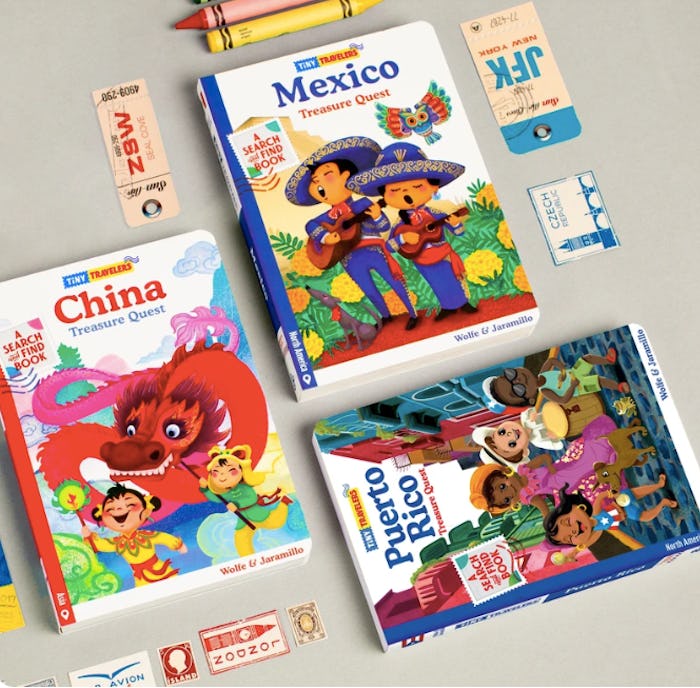Life

Stuck At Home? Explore Other Countries With These Fun Kids' Books
Like yours, my family is homebound right now. We had plans to go to Disneyland soon, and down to Florida and Nicaragua to see family, but with the spread of coronavirus, there’s no telling when we might get to fly anywhere again. Fortunately, a set of books found their way to me that are helping us explore the world from our home. Tiny Travelers is a new book series from Encantos that’s all about celebrating multiculturalism.
Each "treasure quest" book takes you on a kid-friendly journey to China, Mexico, and Puerto Rico, and elsewhere, with a map of the country, along with fast facts like population numbers and currency, as well as pages of information about cultural traditions and festivities, the flora and fauna, words in the country’s native languages, and more. They’re brightly colored, easy to read, and super enjoyable for parents and littles alike.
At a time when anti-Chinese and anti-Asian sentiment is high, though, I felt compelled to share the China Treasure Quest book first with my son. We’re already a household that’s big on empathy, equality, and eliminating racism, sexism, and prejudice, but it’s important to reinforce these types of lessons with regularity. Before the schools here in Denver shut down, my son came home asking me about coronavirus. He’s only 6, but I don’t know if he heard any of the ignorant comments floating out there, like the ones from our nation’s president referring to it as the “Chinese virus.” Children are so damn impressionable, and it’s important to remind them, especially at times like these, that it’s never OK to speak negatively about an entire nation or an entire race. Learning about other cultures is of course a great antidote to a lack of empathy, and the Tiny Travelers books are such a great tool in that respect.
On our “quest” around China, we got to visit the brilliantly lit city of Shanghai, sit in on a Chinese New Year celebration, learn about the pandas in the bamboo forests, and more. And while not a lengthy book, it’s a great jumping off point for other lessons. There’s a section on ping pong, which led us to a chat about the Olympic games. A section on the Chinese operas has inspired me to seek out clips of real Chinese operas that my son can watch on YouTube. And another section on dragon boat festivals reminds me to mark down when the next dragon boat festivals happen in town, so we can go see them for ourselves (once lockdown is over, of course).
Our next book “journey” took us to Mexico, another country near and dear to my heart. My grandfather was Mexican, and though my father was raised in Nicaragua, he was born in Mexico City. Unfortunately, my abuelo died young and so I never really got the opportunity to explore that cultural side of my family. But it’s important to me to continue to learn about this part of my family history, and for my son to know about it as well.
I loved “venturing” around Mexico with my son, learning about the flower-laden trajineros (gonodola-like boats found in Xochimilco) and discovering the various animals that inhabit the jungles of Chiapas (like the tapirs and howler monkeys). While discussing the mariachis, I made a note to turn it into a lesson (because homeschooling!) on some of the most famous mariachis in history. And the section on the alebrije (colorful mythical creatures) parade has inspired me to do an art lesson using papier-mâché so we can make our own soon.
We haven’t read the Puerto Rico book just yet, but as a Latina who grew up around a slew of individuals from various Latin American backgrounds, I get frustrated when people try to lump us all together as though we’re all the same culturally, and love that these books individuate the cultures — Venezuelan culture is different from Cuban, different from Mexican, different from Peruvian. Each of our nations have similarities, but our foods vary, our slang varies, our celebrations vary. As I turn the pages of the book on Puerto Rico, I see a table of the nation's cuisine including arroz con gandules, alcapurrias, and mofongo. And while there’s a page dedicated to their beautiful beaches, it’s not the only thing they focus on. There’s also sections on the bioluminescent bay in Vieques, the impressive observatory in Arecibo, and other points of interest many might not know about.
I know it’s not the same to read about a place as it is to visit it, but right now it’s all our jobs to stay home and keep ourselves (and everyone around us) as safe and healthy as possible. It might not be this summer, but eventually, we’ll all get our chance to travel once more. I made it through my first 18 years of life without a single road trip or flight anywhere outside my state. Instead, I used my imagination and the words of others to go to far off places, real and imaginary, and honestly, it was enough. Our children don’t have to feel restrained if we can keep reading them books like these, and reminding them of all the beauty that awaits them out there.